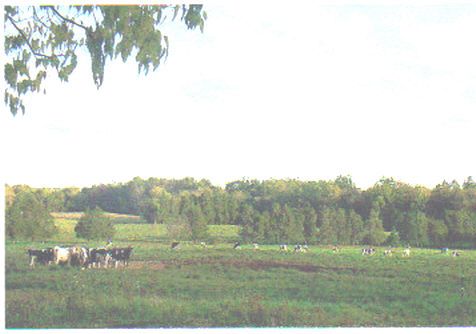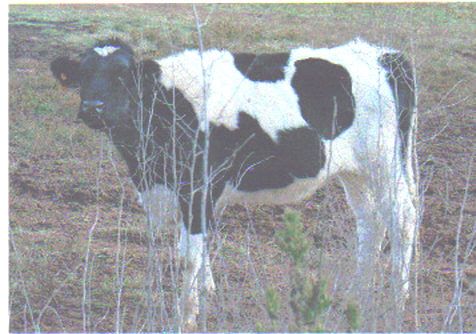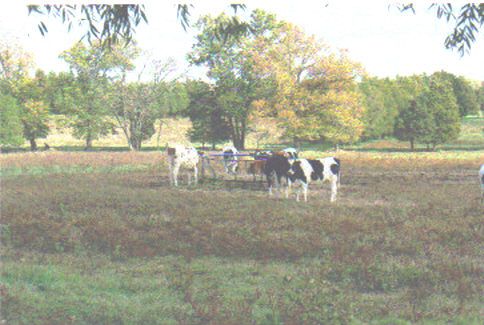
Fall 2007
10/24/05
On October 24, 2006, my son, who loves to visit his grandparents on the farm and I went to see Alan and Barbara Day. They operated a dairy farm for many years, and now raise crops and dairy heifers for another farmer. We arrived around 9 am. We spent the morning watching the cows as they alternately grazed the pasture, ate hay from a round metal hayrack and lay down. Cows sleep in a sitting position. Rarely do they flatten out. This might be an instinct to be able to watch for predators. Through this paper I will try and give you a view of the life cycle of a dairy cow and what it takes to make them good dairy cows.
First lets go though their life cycle.
When a dairy calf is born during the first 3 days the baby calf is fed colostrums, or mothers first milk. The first milk is important because it contains antibodies, which boost the calfs immune system. These antibodies are absorbed by the calfs intestinal tract. After that they get specially formulated powdered milk. Grain, hay and water are also fed to prepare them for weaning until they are 3 months old. Around the age of three month, when they are eating the grain, hay and water well, they are weaned from the powdered milk, and moved from the calf hutches to groups of less than ten. If you do not group them the older, larger calves dominate the groups, and the small ones do not do well. At about six months of age they are moved to larger groups. They do not get to stay babies for long. At about fifteen months of age they are bred either by a bull or artificially. Heifers (which is what a teenage calf is called, after she has a calf, she is the officially a cow) are bred to freshen of calf the first time at about two years of age.
A cow exhibits a heat cycle every twenty-one days at which time she can be bred. Much oftener than I would have thought. When they are in heat, the cows are restless, some times moo a lot, and other cows, ride or hop on her back. About ten or twelve hours after these signs are observed, the farmer will breed the cow, waiting for the egg to be at the right stage for conception. The gestation period for a cow is nine months, the same as for humans. Cows are not rebred until they have been fresh for sixty days. If she becomes pregnant, she is milked until she is seven months along and then dried off, and separated from the milking herd, where she receives a different diet.
Dairy cows are milked two or three times a day, depending on what a farmer decides is beneficial for his herd. The milking times are at the same time, and the cows know when it time to be milked, and will complain loudly if it is late. I dont know whether they make such noise because they want something to eat, or whether they have a lot of milk.
As you see being a cow is hard work. Most of their life they are pregnant or just had calves. The average life of a dairy cow is about five or six years, but if healthy, will go as many as eight or more lactations. These are the cows that really make you money.

Now that I have talked about the life cycle of a cow, let's go back to what I saw during my day on the farm. The first thing I asked the farmer is how many animals were out there, because when you look at them, it is actually really hard to count them because they blend so good together and they do not stand still to long; they have a group of 43 cows and 2 bulls. The cows in this group are called Holsteins. The cows are black and white, some predominantly black and some predominantly white. One bull is Holstein (black and white), but they also have a brownish Jersey bull, which is used, because the calves are small than a Holstein and therefore heifers have an easier calving.
Barbara had taken some notes for me for the time that I was not there. From the notes, at daylight the cows get up and begin to graze and eat hay. They stretch, and when they make manure you can see steam rising in the early morning light. The cows begin grazing and eating hay. The group does spread out some but most of them stay together around the hay bale, and later in the morning move over the pasture grazing more. This goes on for a lot of hours they were still doing this when I got there around nine.
I noticed that the cows were standing sideways to the sun to absorb warmth as it was a cool morning. In the summer time on the other hand they are in the shade most of the day when the sun is strong. The cows move slowly. They are not a fast moving animal, they just wander around on the field eating the grass and getting some water.

The day went by slowly because there is not much going on. At noontime the cows start lying down to rest. You see a lot of them lying around and not moving at all. When they are laying down they swipe their tail to get the flies away from their body. Of course the cows do not do everything at the same time some are feeding when the other are resting and the other way around. The cows knows when they are supposed to get food of the farmer. Because this resting/feeding was going on until around 3 pm. When it is time for them to get food in the barn, they knew. They start getting restless and the whole group starts walking up to the barn. If they are not fed when they are used to being fed, they start making noise. In the barn they get grain pellets. The fun thing to see with the cows was that if Mr. Day went close to the barn around this time of day the group of cow tarted showing the signs of wanting food. You could see it, the whole group starting mooing, and moving around the barn. After they were done eating they wandered around in the field again. Some laid down others walked around eating grass.

Then later at around 5 pm Mr. Day puts out a bale of hay in the field and most of the cows go up to it and eat. The cows cannot get enough from just the grass on the ground they have to get feed by hay and pellets to get enough nutrients. Later in the evening the cows started sniffing, licking, and bumping into each other. The bull normally does his job in nighttime. The cows in this group have all been artificially breed, but sometimes that do not work thats when the bull has to finish the job. That was my day at the farm let me now show you some important about how to get a healthy cow.
Here are some important facts about what you have to know if you want to get a good and healthy milking cow. Of course they need good food like hay, pellets and fresh water accessible all the time. One thing that is very important is that you have to milk at thesame time everyday. You can either milk 2 or 3 times a day. This farm used to milk two times a day. The first time around 4-5 am and the second time around 4-5 pm. The cows also know when its milking time they normally comes up to the barn where they get in line to be milked. The cows also have to get vaccinated and their feet need to be trimmed regularly. A vet normally comes to the farm at least once a month to check for pregnancy, and at the same time they check the cows for any infections or other health problems. These are some of the main points of how to raise a healthy cow, but like Ms. Day says there is always something you have to do to keep your cows healthy.
As you can see, being a farmer is not an easy occupation. One thing that I see from it is that since you have to milk and feed at the same time everyday. You cant really go anywhere. You have to always be home at certain times of day. This makes it hard to be able to go on any vacations. My husband tells me that when he was young they did not really travel a lot because it was first of all hard to get away since you had to find someone that was willing to take care of the farm and do a good job while you are gone, plus the fact that it cost a lot of money to go on vacation when you also have to pay someone to work at home while you are gone. But like he says being on the farm itself was fun. They always had a lot to do. He is the youngest of five kids, and he also told me that there was always someone that wanted to come to spend their vacation at the farm, so the life was not to bad. He also tells me that everyone in the family as soon as they could, would help out on the farm doing small jobs.
Being raised at a farm means every one pitches in to help with the work. For me who has entered into this family later in life it is hard to understand how much work it is, because I do not live there all the time. It looks easy when you just show up sometimes. I do think that they had a nice, but hard life being a milking farm. I know my husband benefited from it later in life.